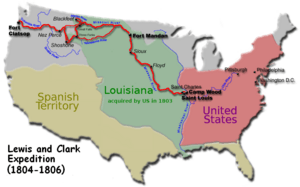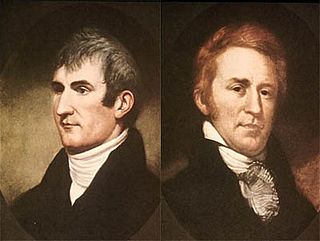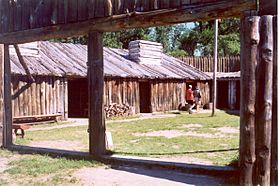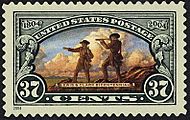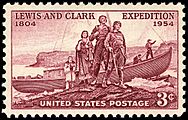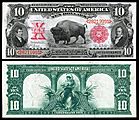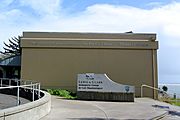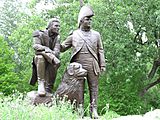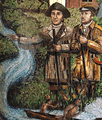Lewis and Clark Expedition facts for kids
The Lewis and Clark Expedition was an expedition by Meriwether Lewis (1774–1809) and William Clark (1770–1838), two men chosen by United States President Thomas Jefferson to explore the Louisiana Purchase, which the country had just bought from France. (This land was made up of much of what is now the Central and Western United States). They left Saint Louis in 1804, leading a group of 33 people. The group reached the Pacific in 1806, viewing much of the West on the way and writing down what they saw. Along the way, the group was joined by a Shoshone Native American woman named Sacagawea, who helped guide them. After their exploration, Lewis became Governor of Louisiana Territory, and Clark became Governor of Missouri Territory.
Contents
Timeline
The timeline covers the primary events associated with the expedition, from January 1803 through January 1807.
Preparations
For years Jefferson had heard of and read accounts of the various ventures of other explorers in parts of the western frontier and consequently had a long held interest in further exploring this largely still unknown region of the continent. In the 1780s, while Minister to France, Jefferson met John Ledyard in Paris and discussed a proposed trip to the Pacific Northwest.
Jefferson had also read Captain James Cook's A Voyage to the Pacific Ocean (London, 1784) an account of Cook's third voyage, and Le Page du Pratz'z The History of Louisiana ...(London, 1763) all of which greatly influenced his decision to send an expedition. Like Captain Cook, Jefferson also wished to discover a practical route through the Northwest to the Pacific coast. However it was Alexander Mackenzie's publication of 1801, Voyages from Montreal, which revealed to Jefferson, who had read the book at Monticello in 1802, of Britain's declaration of its intent to control the lucrative fur trade of the Columbia River, that convinced him of the importance of securing the territory as soon as possible.
Two years into his presidency, President Thomas Jefferson asked Congress to fund an expedition through the Louisiana Purchase, and to the Pacific Ocean.
In 1803, Jefferson commissioned the Corps of Discovery, and named U.S. Army Captain Meriwether Lewis its leader, who in turn selected William Clark as second in command.
Lewis demonstrated remarkable skills and potential as a frontiersman. As the expedition was gaining approval and funding Jefferson made efforts to prepare him for the long journey ahead.
Lewis and Clark met near Louisville in October of 1803 at the Falls of the Ohio and before departing later in the month, the core "Nine Young Men" were enlisted into the Corps of Discovery. Their goals were to explore the vast territory acquired by the Louisiana Purchase and to establish trade and U.S. sovereignty over the native peoples along the River Missouri. Jefferson also wanted to establish a U.S. claim of "Discovery" to the Pacific Northwest and Oregon territory by documenting an American presence there before Europeans could claim the land.
The U.S. mint prepared special silver medals with a portrait of Jefferson and inscribed with a message of friendship and peace, called Indian Peace Medals or peace medals. The soldiers were to distribute them to the nations they met. These symbolized U.S. sovereignty over the indigenous inhabitants. The expedition also prepared advanced weapons to display their military firepower. Among these was an air rifle of about .44 caliber, powerful enough to kill a deer.
The expedition was prepared with sufficient black powder and lead for their flintlock firearms, knives, blacksmithing supplies, and cartography equipment. They also carried flags, gift bundles, medicine and other items they would need for their journey. Much time went into ensuring a sufficient supply of these items.
The route of Lewis and Clark's expedition, took them up the Missouri River to its headwaters, then on to the Pacific via the Columbia River.
Journey
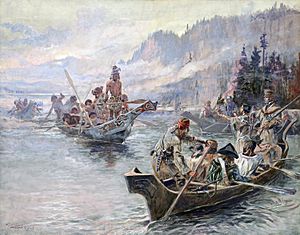
There were 33 people, including 29 participants in training at the 1803–1804 Camp Dubois (Camp Wood) winter staging area in Indiana Territory, near present day Wood River, Illinois. They left on May 14, 1804, and met up with Lewis in St. Charles, Missouri, a short time later; the corps followed the Missouri River westward. Soon they passed La Charrette, the last Euro-American settlement on the Missouri River.
The expedition followed the Missouri through what is now Kansas City, Missouri, and Omaha, Nebraska. On August 20, 1804, Sergeant Charles Floyd died, apparently from acute appendicitis. He was the only member of the expedition to die, and was among the first to sign up with the corps of Discovery. He was buried at a bluff by the river, now named after him, in what is now Sioux City, Iowa. His burial cite was marked with a cedar post on which was inscribed his name and day of death. A mile up the river the expedition camped at a small river which they names Floyd's River. During the final week of August, Lewis and Clark reached the edge of the Great Plains, a place abounding with elk, deer, bison, and beavers.
The Lewis and Clark Expedition established relations with two dozen indigenous nations, without whose help the expedition would have starved to death or become hopelessly lost in the Rocky Mountains.
The Americans and the Lakota nation (whom the Americans called Sioux or "Teton-wan Sioux") had problems when they met, and there was a concern the two sides might fight.
One of their horses disappeared, and they believed the Sioux were responsible. Afterward, the two sides met and there was a disagreement, and the Sioux asked the men to stay or to give more gifts instead before being allowed to pass through their territory. They came close to fighting several times, and both sides finally backed down and the expedition continued on to Arikara territory.
In the winter of 1804–05, the party built Fort Mandan, near present-day Washburn, North Dakota. One chief asked Lewis and Clark to provide a boat for passage through their national territory. As tensions increased, Lewis and Clark prepared to fight, but the two sides fell back in the end. The Americans quickly continued westward (upriver), and camped for the winter in the Mandan nation's territory.
After the expedition had set up camp, nearby Indians came to visit in fair numbers, some staying all night. For several days Lewis and Clark met in council with Mandan Indian chiefs. Here they met a French-Canadian fur trapper named Toussaint Charbonneau, and his young Shoshone wife Sacagawea. Charbonneau at this time began to serve as the expedition's translator. Peace was established between the expedition and the Mandan Chiefs with the sharing of the Mandan peace pipe.
They followed the Missouri to its headwaters, and over the Continental Divide at Lemhi Pass. In canoes, they descended the mountains by the Clearwater River, the Snake River, and the Columbia River, past Celilo Falls and past what is now Portland, Oregon at the meeting of the Willamette and Columbia Rivers. Lewis used William Robert Broughton's 1792 notes and maps to find the stratovolcano mountain for navigation.
The expedition faced its second bitter winter, and on November 24, 1805 voted on whether to camp on the south side of the Columbia river (modern Astoria, Oregon), building Fort Clatsop. By March 22nd the stormy weather had subsided and the following morning the Corps began their journey homeward using canoes, and later by land.
On July 3, before crossing the Continental Divide, the Corps split into two teams so Lewis could explore the Marias River. Lewis' group of four met some men from the Blackfeet nation. During the night, the Blackfeet tried to steal their weapons. In the struggle, the soldiers killed two Blackfeet men. Lewis, Drouillard, and the Field brothers, fled over 100 miles (160 km) in a day before they camped again.
Meanwhile, Clark had entered the Crow tribe's territory. In the night, half of Clark's horses disappeared, but not a single Crow had been seen. Lewis and Clark stayed separated until they reached the Yellowstone and Missouri Rivers on August 11. Before reuniting, one of Clark's hunters, Pierre Cruzatte, mistook Lewis for an elk and fired, injuring Lewis in the thigh. Once reunited, the Corps were able to return home quickly via the Missouri River. They reached St. Louis on September 23, 1806.
The Corps met their objective of reaching the Pacific, mapping and establishing their presence for a legal claim to the land. They established diplomatic relations and trade with at least two dozen indigenous nations. They did not find the Northwest Passage.
In March of 1804, the Spanish in New Mexico learned from U.S. General James Wilkinson, later discovered to be a paid agent of the Spanish crown, that the Americans were encroaching on territory claimed by Spain. On August 1st, they sent four armed expeditions of fifty two soldiers, mercenaries, and Indians from Santa Fe northward under Pedro Vial and José Jarvet, to intercept Lewis and Clark and imprison the entire expedition. When they reached the Pawnee settlement on the Platte River in central Nebraska they learned that the expedition had been there many days before, but because the expedition at that point was covering seventy to eighty miles a day Vial's attempt to intercept them was unsuccessful.
Geography, science
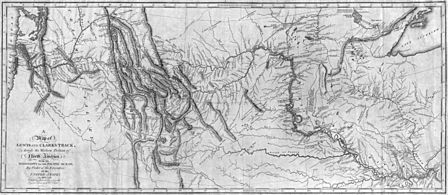
The Lewis and Clark Expedition gained an understanding of the geography of the Northwest and produced the first accurate maps of the area. During the journey, Lewis and Clark drew about 140 maps. Stephen Ambrose says the expedition "filled in the main outlines" of the area.
The expedition documented natural resources and plants that had been previously unknown to Euro-Americans, though not to the indigenous peoples. Lewis and Clark were the first Americans to cross the continental divide, the first Americans to see Yellowstone and enter into Montana and produce an official description of these different regions. Their visit to the Pacific Northwest, maps, and proclamations of sovereignty with medals and flags were legal steps needed to claim title to each indigenous nations' lands under the Doctrine of Discovery.
Lewis and Clark's expedition had no greater advocate and no greater beneficiary, than the American Philosophical Society (APS). Their duties, as assigned by Jefferson, were preeminently scientific. Specifically, they were instructed in geography, astronomy, ethnology, climatology, mineralogy, meteorology, botany, ornithology, and zoology.
The expedition recorded more than 200 plants and animals that were new to science and noted at least 72 native tribes.
Jefferson had the expedition declare "sovereignty" and demonstrate their military strength to ensure native tribes would be subordinate to the U.S., as European colonizers did elsewhere. After the expedition, the maps that were produced allowed the further discovery and settlement of this vast territory in the years that followed.
In 1807 Patrick Gass a private in the US Army, published an account of the journey. He was promoted to Sergeant during the course of the expedition. Paul Allen edited a two-volume history of the Lewis and Clark expedition that was published in 1814, in Philadelphia, but without mention of the actual author, banker Nicholas Biddle. Even then, the complete report was not made public until more recently. The earliest authorized edition of the Lewis and Clark journals resides in the Maureen and Mike Mansfield Library at the University of Montana.
Sacagawea

Sacagawea, sometimes called Sakajawea or Sakagawea (c. 1788–December 20, 1812), was an indigenous woman who accompanied her husband Toussaint Charbonneau on the expedition to the Pacific Ocean. Her son Jean Baptiste Charbonneau was born in 1805 with the help of the expedition.
Though she has been discussed in literature frequently, much of the information is exaggeration or fiction. Scholars say she did notice some geographical features, but "Sacagawea...was not the guide for the Expedition, she was important to them as an interpreter and in other ways." The sight of a woman and her infant son would have been reassuring to some indigenous nations, and she played an important role in diplomatic relations by talking to chiefs, easing tensions, and giving the impression of a peaceful mission.
In his writings, Meriwether Lewis presented a somewhat negative view of her, though Clark had a higher regard for her, and provided some support for her children in subsequent years. In the journals, they used the terms "squar" and "savages" to refer to Sacagawea and other indigenous peoples.
Legacy and honors
Since the expedition, Lewis and Clark have been commemorated and honored over the years on various coins, currency, and commemorative postage stamps, as well as in a number of other capacities.
-
Lewis & Clark were honored (along with the American bison) on the Series of 1901 $10 Legal Tender
-
Lewis and Clark Interpretive Center in Cape Disappointment State Park
-
Lewis and Clark statue (with Seaman (dog)) in St. Charles, Missouri
-
Sergeant Floyd Monument in Sioux City, Iowa is the first of 2,600 National Historic Landmarks in the United States
Images for kids
-
Camp Dubois (Camp Wood) reconstruction, where the Corps of Discovery mustered through the winter of 1803–1804 to await the transfer of the Louisiana Purchase to the United States
-
Fort Clatsop reconstruction on the Columbia River near the Pacific Ocean
See also
 In Spanish: Expedición de Lewis y Clark para niños
In Spanish: Expedición de Lewis y Clark para niños


